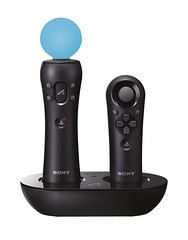Vaporware IMO.
Cool. Hundreds of people tried this "vaporware" saturday.
Vaporware IMO.
Not need to attack the person sean, just respond to his points or not. No need for qualifiers or acting defensive.We've clearly gone past the boundary of reasonable discussion and disagreement. You're merely being stubborn and professing to know more about a topic than would be possible without some inside knowledge. What else is there to say?
Cool. Hundreds of people tried this "vaporware" saturday.
Here's one way of doing it, stick some joysticks to the end of a 'motion capture suit'. This isn't really that relevant considering its five years ago and seemingly hasn't gone anywhere, nor do most of us want to put on a mechanical suit...but it was fun to watch - just putting it out there! (Full disclosure: I'm the author of the article, and Sussex Uni alumnus).

It's kind of hard to refute your "evidence" when it basically boils down to "look at how awesome I am". Seriously, critical mass of information? That's laughable.It is a shame that some people continue to tell me why I am wrong without providing evidence as such. Some have, but so far I feel I have sufficiently explained why it has not changed my conclusion.
A) you look at your keyboard when you type?
B)
It's kind of hard to refute your "evidence" when it basically boils down to "look at how awesome I am". Seriously, critical mass of information? That's laughable.
The closest thing to an actual argument you have made is, as I understand it, that only companies and/or people who have previously made fundamental hardware inventions are capable of doing so again. Why this is inherently false shouldn't need to be explained.
Seems like a lot of people missed the point.
The developers want "your hands inside the game so you can use them the way you would in the real world."
A controller isn't gonna cut it. They need gloves or some kind of finger-tracker.
Ironically, I think using your hands like in real life would actually be pretty limiting, gameplay-wise. It'd be really hard to pull off awesome moves if you actually had to pull them off with your real hands. A controller is the best option.
I'm not 100% sure what problem they are trying to solve to be honest, and if I'm getting the gyst of it (permanently track your hands even when off screen) I'm not sure that is even the direction they should be going in.
Basically, the holy grail is solving this:I'm not 100% sure what problem they are trying to solve to be honest, and if I'm getting the gyst of it (permanently track your hands even when off screen) I'm not sure that is even the direction they should be going in.
Exactly. And I don't feel like a controller, even a motion controller, is really suitable for this (though it might be the best we can do right now).Their problem is eliminating anything that breaks the feeling of presence. One of the first things people do when they put the rift on is reach out to try and touch something. Letting them to do that (albeit without any actual touch feedback) helps keep the illusion going, maintaining presence.
If it were really VR you wouldn't need a controller.

Take your pick.


Real life can only aspire to be G Gundam.I would prefer something like this but I guess the technology isn't there yet.

I would prefer something like this but I guess the technology isn't there yet.

Why do you classify this as a "guess"? The DK2 and Crescent Bay clearly show that's what they're focusing on.My guess as to what Oculus will come up with? An outside-in positional tracking system.
I think literally the only thing suitable for this is a haptic solution. It doesn't matter nearly as much how precise and accurate the hand/finger tracking is: if you don't feel anything when you touch, immersion will fail utterly.In my experience, one of the first thing people (of any age) do when you put them in VR is try to touch things.
...And I don't feel like a controller, even a motion controller, is really suitable for this (though it might be the best we can do right now).
Why do you classify this as a "guess"? The DK2 and Crescent Bay clearly show that's what they're focusing on.
I think literally the only thing suitable for this is a haptic solution. It doesn't matter nearly as much how precise and accurate the hand/finger tracking is: if you don't feel anything when you touch, immersion will fail utterly.
This is why I believe Move, Stem, etc.--not to mention traditional controllers--have been far more effective in VR demonstration than their accuracy would predict: thumbing a stick, pulling a trigger, or pushing a button provide feedback. That contributes greatly to a sense of reality, even if what you're supposedly touching isn't stick- or trigger- or button-shaped. (And even if your virtual hand lags a bit, or suddenly skips to another position.)
If I'm right, a very technically adroit positional system that has no haptics would subjectively feel less good. Even if it beat the pants off the current "kludge" systems in terms of latency, precision, etc.
I get the impression that Carmack and crew are being too obsessive about latency. While it is important for the headset to avoid motion sickness, it's not as crucial for control. We're not as accurate in our perception of our limbs as we are for our vision, and we have a good "feedback correction" for possible delays between intended and observed motion.
Wanting to make too perfect a product is the best way to never release it, or release it too late.
Because I think it is contrary to what they are ultimately working towards with the headset itself - markerless inside-out positional tracking.
Conventional force display systems provide a force sensation by applying force to the operator's body via actuators such as electric motors. These systems can potentially harm the operator, especially when providing a large force sensation. This study shows that constrictive pressure on the distal part of the forearms provides a force sensation such as holding a heavy object or pushing a wall when the pressure changes in accordance with the hand motion.
Price I guess?What about these?
With control, you can't 'cheat' like with time warp. It has to go through the whole pipeline.I get the impression that Carmack and crew are being too obsessive about latency. While it is important for the headset to avoid motion sickness, it's not as crucial for control.
Absolute volume levels and better control of 3D audio.I'm not sure what would be so special about them that a *proper* nice set of headphones wouldn't be able to take advantage of.

This doesn't make sense.
That's a bit of an exaggerated thread title.
Its more that they're unsure of what the most ideal solution is at this point. There's plenty of things they can do, but committing to a 'standard' this early is dangerous as you don't want everybody to be working with an un-ideal framework in mind. Its good for the short-term, but they do not want people thinking within boxes like that.
It would be plenty easy to just create a slightly altered 360 pad, perhaps a VR-specific keyboard/mouse setup(with touch sensitive mappings) or even just copy what Sony has with Move. But they're not happy with that. They want something great. Something that they'll be happy to tell everybody, "This is what you should make games and experiences around."



Take your pick.
A) you look at your keyboard when you type?
B)
Sony, with all their hardware expertise and incredible resources, have Move. Decent control scheme, mind you. But that is their solution to this. And Oculus obviously don't feel its good enough. For good reason. *IF* the problem is that the technology just isn't there, its not because Oculus is just some startup company without the knowhow. They aren't the only ones attacking this field.
